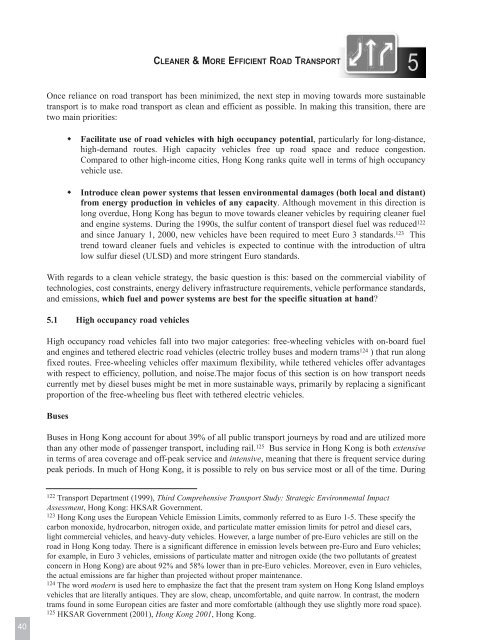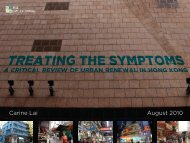Untitled - Civic Exchange
Untitled - Civic Exchange
Untitled - Civic Exchange
You also want an ePaper? Increase the reach of your titles
YUMPU automatically turns print PDFs into web optimized ePapers that Google loves.
CLEANER & MORE EFFICIENT ROAD TRANSPORT<br />
5<br />
Once reliance on road transport has been minimized, the next step in moving towards more sustainable<br />
transport is to make road transport as clean and efficient as possible. In making this transition, there are<br />
two main priorities:<br />
• Facilitate use of road vehicles with high occupancy potential, particularly for long-distance,<br />
high-demand routes. High capacity vehicles free up road space and reduce congestion.<br />
Compared to other high-income cities, Hong Kong ranks quite well in terms of high occupancy<br />
vehicle use.<br />
• Introduce clean power systems that lessen environmental damages (both local and distant)<br />
from energy production in vehicles of any capacity. Although movement in this direction is<br />
long overdue, Hong Kong has begun to move towards cleaner vehicles by requiring cleaner fuel<br />
and engine systems. During the 1990s, the sulfur content of transport diesel fuel was reduced 122<br />
and since January 1, 2000, new vehicles have been required to meet Euro 3 standards. 123 This<br />
trend toward cleaner fuels and vehicles is expected to continue with the introduction of ultra<br />
low sulfur diesel (ULSD) and more stringent Euro standards.<br />
With regards to a clean vehicle strategy, the basic question is this: based on the commercial viability of<br />
technologies, cost constraints, energy delivery infrastructure requirements, vehicle performance standards,<br />
and emissions, which fuel and power systems are best for the specific situation at hand<br />
5.1 High occupancy road vehicles<br />
High occupancy road vehicles fall into two major categories: free-wheeling vehicles with on-board fuel<br />
and engines and tethered electric road vehicles (electric trolley buses and modern trams 124 ) that run along<br />
fixed routes. Free-wheeling vehicles offer maximum flexibility, while tethered vehicles offer advantages<br />
with respect to efficiency, pollution, and noise.The major focus of this section is on how transport needs<br />
currently met by diesel buses might be met in more sustainable ways, primarily by replacing a significant<br />
proportion of the free-wheeling bus fleet with tethered electric vehicles.<br />
Buses<br />
Buses in Hong Kong account for about 39% of all public transport journeys by road and are utilized more<br />
than any other mode of passenger transport, including rail. 125 Bus service in Hong Kong is both extensive<br />
in terms of area coverage and off-peak service and intensive, meaning that there is frequent service during<br />
peak periods. In much of Hong Kong, it is possible to rely on bus service most or all of the time. During<br />
122 Transport Department (1999), Third Comprehensive Transport Study: Strategic Environmental Impact<br />
Assessment, Hong Kong: HKSAR Government.<br />
123 Hong Kong uses the European Vehicle Emission Limits, commonly referred to as Euro 1-5. These specify the<br />
carbon monoxide, hydrocarbon, nitrogen oxide, and particulate matter emission limits for petrol and diesel cars,<br />
light commercial vehicles, and heavy-duty vehicles. However, a large number of pre-Euro vehicles are still on the<br />
road in Hong Kong today. There is a significant difference in emission levels between pre-Euro and Euro vehicles;<br />
for example, in Euro 3 vehicles, emissions of particulate matter and nitrogen oxide (the two pollutants of greatest<br />
concern in Hong Kong) are about 92% and 58% lower than in pre-Euro vehicles. Moreover, even in Euro vehicles,<br />
the actual emissions are far higher than projected without proper maintenance.<br />
124 The word modern is used here to emphasize the fact that the present tram system on Hong Kong Island employs<br />
vehicles that are literally antiques. They are slow, cheap, uncomfortable, and quite narrow. In contrast, the modern<br />
trams found in some European cities are faster and more comfortable (although they use slightly more road space).<br />
125 HKSAR Government (2001), Hong Kong 2001, Hong Kong.<br />
40

















